Main page
About us
Sliding Bearings Consulting
Advertising Opportunities

SubsTech’s sister website Smooth Sliding provides independent engineering consulting services that help you to solve engine bearing related issues: failures, material selection, geometry design and optimization of hydrodynamic conditions.
Smooth Sliding is an engineering consulting company run by Dr. Dmitri Kopeliovich:
- VP R&D of King Engine Bearings.
- World leading expert (32 years of experience) in design, technology and materials for Engine bearings in applications such as automotive, renewable energy, aviation, racing and others.
- Founder and owner of SubsTech (Substances & Technologies) – a leading professional website on Materials Science and Engineering.
- Author of numerous scientific and engineering publications and patents.
- Founder and owner of Smooth Sliding.
For further information and for requesting consulting services please visit our sister website Smooth Sliding.
to Metals
to Engine bearings
Engine bearing failure
Dr. Dmitri Kopeliovich
Engine bearings are small and relatively inexpensive components of internal combustion engines however failure of an engine bearing commonly leads to serious reconditioning works of the engine including its disassembling, regrinding the crankshaft and replacing the bearings.
Factors affecting normal functioning of engine bearings:
-
-
- Diameter
- Length
- Thickness
- Parameters of the internal combustion engine, which determines functioning conditions of the bearings:
- The engine type (gasoline, diesel with direct fuel injection, diesel with indirect fuel injection).
- Compression ratio.
- Rotation speed.
- Aspiration type (naturally aspirated, turbocharged, supercharged).
- Combustion parameters.
- Lubrication system:
- Oil pressure and flow rate provided by the oil pump.
- Oil supply through the oil filter, oil passages and the bearings oil holes.
- Level of the oil contamination.
- Geometry imperfections and misalignment:
- Excessive or insufficient bearing crush.
- Bearing back non-conformed to the round housing bore.
- Improperly ground housing bore.
- Improperly ground journal (taper shape, barrel shape, hour glass shape).
- Excessive fillet of the journal.
- Distorted connecting rod.
- Distorted crankcase.
- Distorted (bent) crankshaft.
- Rough Crankshaft surface.
- Engine work conditions:
- Work under high torque at low rotation speed (climbing) for a long period .
- Work at a rotation speed beyond the upper limit.
- Non-authorized “improvements” of the engine for power increase.
The major type of engine bearing failure is Fatigue.
Fatigue of engine bearing materials is caused by running the bearing at a load above the fatigue limit.
The causes of engine bearing fatigue:
- Wrong selection of the Engine bearing materials for the application.
- Localized loading of the bearing due to a misalignment (eg. hour glass journal, distorted connecting rod).
- Fuel detonation caused by advanced ignition.
- Running the engine under high loads (torque) at low rotation speeds for long period.
- Poor conforming of the bearing back with the housing surface.
- Over fueling.
- Corrosive action of contaminated oil, which lowers the fatigue limit (Corrosion fatigue).
Types of engine bearing failure:
Fatigue of overlay
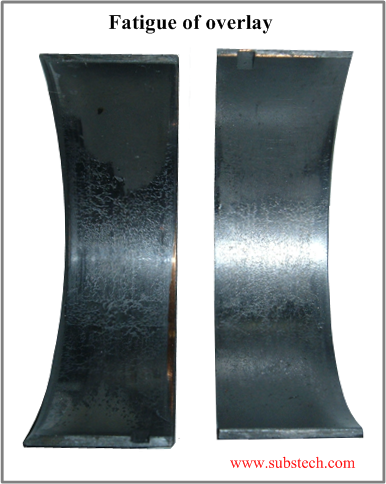
Fatigue of an overlay appears in form of a network of thin cracks.
Thinner overlays form thinner fatigue cracks.
Fatigue limit of an overlay is determined by the strength of the material and the thickness of the overlay. The thinner the overlay the higher its fatigue strength.
Overlay fatigue itself does not cause the engine failure.
However running the bearing with fatigued overlay for a long time may cause partial flaking of the overlay and lowering the oil film thickness.
The conditions for boundary lubrication occurred at low oil film thickness lead to excessive wear and localized loading, which may result in the failure of the lining (intermediate layer).
to top
Fatigue of copper based lining
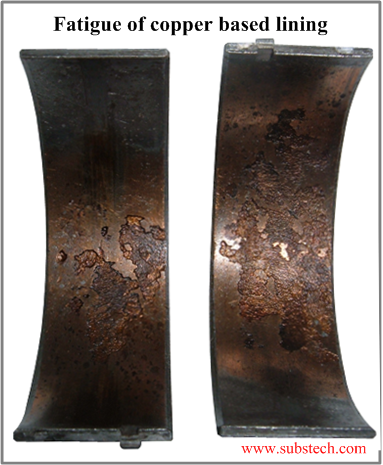
Fatigue of a copper based lining starts from fatigue of the overlay.
The overlay flakes out from the copper lining resulting in breaking the oil film and changing the lubrication regime from hydrodynamic to boundary.
The load localizes at the contact area causing formation of small cracks on the lining surface.
The cracks then spread throughout the lining thickness, meet the steel back surface and continue to advance along the steel-copper boundary.
As a result parts of the intermediate layer detach from the steel surface.
Fatigue of copper lining causes immediate engine failure.
to top
Fatigue of aluminum based lining
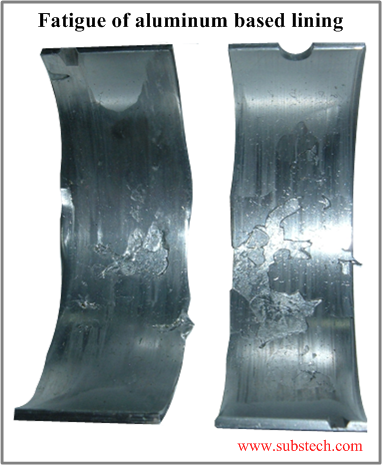
Appearance of fatigue of aluminum based lining is similar to that of copper base lining.
It is also result of overloading caused by running the engine under high loads (torque) at low rotation speeds for long period, localized loading of the bearing due to a misalignment, fuel detonation or other factors.
The fatigue cracks form on the surface and spread inside the lining reaching the steel back.
The cracks then progress along the bond line between the lining and the steel.
Pieces of the lining flake out from the steel back resulting in the engine failure.
Fatigue of aluminum alloys may also cause extrusion of the lining material out of the bearing edges.
to top
Metal-to-metal contact
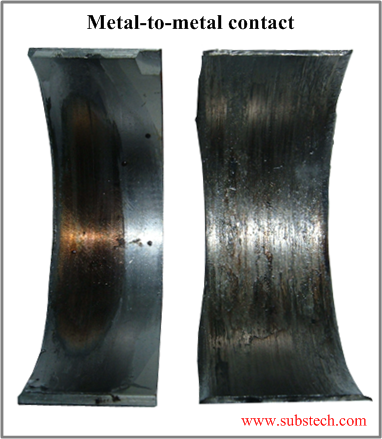
Metal-to-metal contact (boundary lubrication) may be a result of different factors:
- Insufficient oil conditions (oil starvation).
- Breaking the oil film caused by the bearing material Fatigue.
- Misalignment (eg. hour glass journal, distorted connecting rod).
- Poor journal surface finish.
- Foreign particles embedded into the bearing surface.
Metal-to-metal contact may appear in the following forms:
- Accelerated wear: the bearing is not overheated (shining appearance).
- Wiping: the bearing is heavily worn (overlay is partially disappeared), there are signs of overheating (blackening), partial melting of the overlay. An example of a wiped bearing is presented on the left part of the picture.
- Hot Short: severe wear, torn surface, heavy overheating, melted overlay and lining material. An example of a Hot Short bearing is presented on the right part of the picture.
Bent or twisted connecting rod
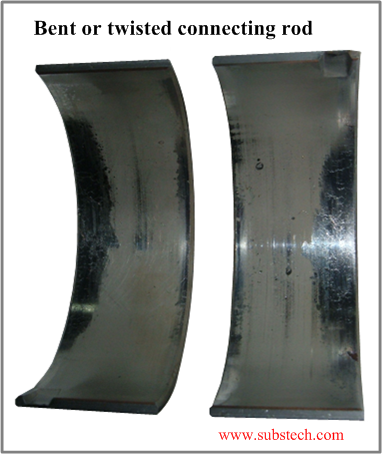
Distorted (bent or twisted connecting rod) is one of the causes of localized loading of engine bearings.
Overloading of an internal combustion engine due to detonation or running under high torque at low rotation speed may cause distortion of the connecting rods.
The distortion results in non-parallel orientation of the bearing and journal surfaces.
The misalignment causes localized excessive wear of the bearing surface due to metal-to-metal contact (boundary lubrication) occurring near the bearing edge.
Localized metal-to-metal contact may also cause Fatigue cracking of the Engine bearing materials in the locations of the contact.
to top
Imperfect journal geometry

Imperfect journal geometry is also a cause of localized loading of engine bearings.
Use of a worn stone in grinding a crankshaft results in obtaining an imperfect (out-of-shape) journal surface: taper shape, hour glass shape or barrel shape.
The parts of the journal surface having higher diameter (central part of the barrel shape journal, edge parts of hour glass shape journal) come to metal-to metal contact (boundary lubrication) with the bearing surface.
The metal-to-metal contact causes excessive wear.
Fatigue cracking of the Engine bearing materials may occur in the contact areas.
to top
Cavitation erosion
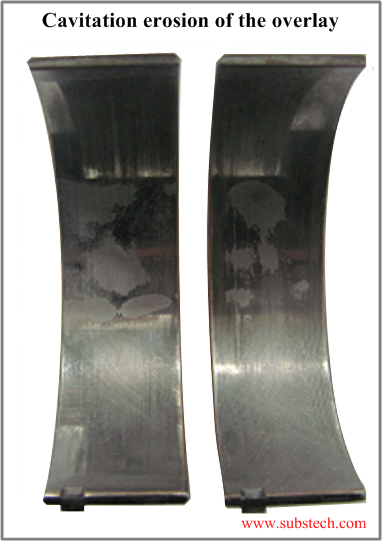
Cavitation occurs when the load applied to the bearing fluctuates at high frequency (high RPM).
The oil pressure instantly falls causing formation of cavities due to fast evaporation (boiling).
When the pressure rises the vapor cavities (cavitation bubbles) contract at high velocity. Such collapse results in impact pressure, which may erode the bearing material.
The oil pressure creates a supporting force separating the journal from the bearing surface.
Soft Lead based engine bearing overlays of tri-metal bearings are prone to the cavitation erosion.
to top
Related internal links
to Metals
to Engine bearings


